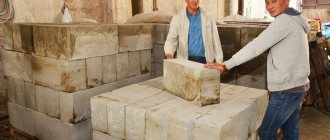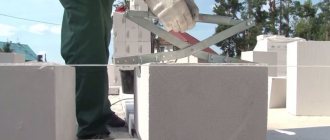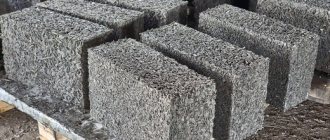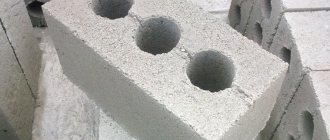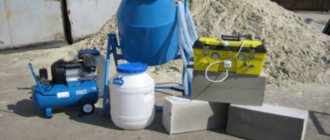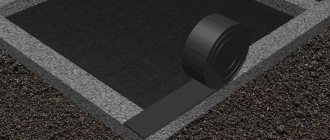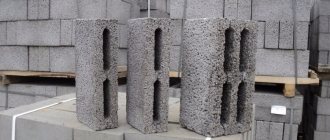Home |Blocks and floors |How to make wood concrete blocks with your own hands?
Date: January 22, 2018
Comments: 0
When choosing a material for building a house, many developers give preference to blocks, the use of which allows them to shorten the construction cycle. The building materials used are subject to requirements for environmental friendliness, strength, thermal conductivity and sound insulation properties. Interest in wood concrete, made from wood chips mixed with cement, is gradually increasing. By making wood concrete blocks with your own hands, you can significantly reduce the overall level of costs. Let us consider in detail the features of the technology.
Properties and scope of arbolite blocks
Arbolite blocks are a wall material of the lightweight concrete group, used in low-rise (up to 3 floors) construction. Their standard size is 200x300x500 mm. Most manufacturers offer a wider range of standard sizes. Residential buildings, low-rise commercial buildings, technical buildings, and outbuildings are used from arbolite blocks.
Residential buildings, commercial and technical buildings, and outbuildings are built from arbolite blocks
Wood concrete as a building material has a huge number of advantages:
- Low thermal conductivity;
- Minimal sound transmission;
- High vapor permeability;
- Biological resistance;
- Fire safety;
- Light weight;
- Convenient format;
- Environmental friendliness;
- Cost-effective and easy to install;
- Durability;
- Low cost.
Light weight and convenient format of wood concrete blocks save time and labor costs for builders
With proper production and use of wood concrete blocks, you will achieve savings on several expense items at once: a lightweight foundation, no additional thermal insulation, reduced heating costs, and a minimum of waste during construction.
The disadvantages of building materials include:
- The need for plastering of walls, protection from water.
- The need to use special masonry compounds - “warm” perlite solutions.
- Possibility of using only “breathable” finishing materials.
- Time spent on producing a sufficient number of products.
- Risk of damage to low-quality blocks by rodents.
Walls made of arbolite blocks should be plastered to protect them from water
You can protect the building from attacks by mice and rats by pouring a high foundation (0.5 m above ground level) or by reinforcing the plaster with a metal mesh.
What is wood concrete made from?
To produce wood concrete blocks you will need the following components:
- wood chips;
- chemical additives;
- cement;
- water.
Requirements for the size of wood chips according to GOST - length up to 25 mm, width 5–10 mm, thickness 3–5 mm
You can take chips of a different size, shavings, sawdust. But remember that too large a fraction reduces the strength characteristics of the block, and a small fraction increases its thermal conductivity.
Experience shows that the most durable wood concrete block is obtained from an elongated needle-shaped filler.
Usually the raw material is pure pine and spruce wood, sometimes hardwood. Chips make up 80–90% of the total volume, which is why the material is often called wood concrete.
The wood concrete block consists of 80–90% wood, so it can be easily cut with a chainsaw
The wood is well dried - humidity no more than 23%. The inclusion of bark and wane up to 10% is allowed. The inclusion of leaves, pine needles, and straw is undesirable.
When selecting filler, proceed from the purpose of the future building. If you intend to build a residential building, the quality of the raw materials is of paramount importance. Wall material for outbuildings can be made from third-rate raw materials, including any plant waste. They just need to be crushed and dried well.
A chemical additive is necessary for the mineralization of wood chips - neutralizing the sugars and resins contained in wood fibers. These natural substances interfere with the adhesion of the cement mortar to the wood and impair its bonding. For mineralization the following are used:
- sodium sulfate (liquid glass).
- aluminum sulfate.
- aluminum chloride.
- calcium chloride.
Chemical additives can be used individually or in pairs in a 1:1 combination.
You can further improve the adhesion of chips and chips with 15% lime milk before drying them. Fill the raw materials with a solution at the rate of 200 liters of solution per 1 m³. Let stand for 4 days, stirring the mixture 3-4 times a day. Then spread the filler out in the open air and stir periodically. The drying process takes 3–4 months.
Cement should be taken only of grade M500, or, as a last resort, M400. It has maximum binding properties, hydrophobicity, and strength.
Specifications
Technical parameters include:
- density;
- strength;
- thermal conductivity;
- water absorption;
- frost resistance;
- fire resistance;
- soundproofing.
Density can range from 400 to 850 kg/m³. Material with a density of up to 500 kg/m³ is used for thermal insulation work, above this value - for the construction of walls. Strength means the ability to withstand different types of loads. The material works well in compression and bending. There is a division into brands from M5 to M50. The higher the number, the greater the strength and density.
The wood in the wood concrete provides high thermal insulation values, which make houses warm in winter and cool in summer. The material is porous, which leads to increased water permeability. The number of freezing and thawing cycles during which strength is maintained determines the frost resistance of the material. For wood concrete it can be from 25 to 50 cycles. Wood concrete is difficult to ignite and does not burn. A mixture of cement and wood filler protects the interior of the house well from external noise.
On a note!
The combination of parameters makes wood concrete blocks an attractive material for the construction of low-rise buildings.
Calculation of raw material consumption
Calculate the required amount of wood concrete based on the total area of the load-bearing walls minus the area of the openings.
- If you intend to make standard blocks of 20x30x50 cm, then one block in the plane of the wall occupies 0.20 x 0.50 = 0.1 m².
- Dividing the total area of the walls in m² by 0.1 m², you will get the number of wood concrete blocks in pieces.
- The amount of finished wall material is measured in cubic meters. The volume of one block is 0.03 m³.
- 1 m³ of wood concrete consists of 33 blocks.
To make 1 m³ of wood concrete you will need:
- 250–300 kg of Portland cement.
- 250–300 kg of dry filler.
- 400 liters of water.
- 8–10 kg of chemical additives.
Equipment and tools
There are machines for sale for making wood concrete blocks at home. They make labor-intensive work easier and faster, but are expensive. If you need wall material only for your home, and you are not afraid of the length of the process, you can do without expensive equipment.
You will need:
- forced action concrete mixer;
- shovel;
- block molds;
- polyethylene film;
- wooden pallets;
- hammer;
- tamper block.
Arbolite blocks should be dried for 30 days in a warm place, protected from rain and wind.
For the production of wood concrete, a forced-action concrete mixer is used
The form is made of steel sheet or wooden formwork. The metal mold consists of two parts. The box is made of steel with a cross-section of 1.0–1.5 mm. Its size is 30 x 50 cm, height 30 cm. The lid is made of steel with a cross-section of 3.0 mm and measures 33 x 53 cm. Apply clearly visible marks on the inner walls of the box at a height of 20.5 cm from the bottom. It’s even better to weld hooks about 5 mm high along the mark line, which will fix the lid to the given block thickness.
The mold for wood concrete blocks is made of steel with a cross section of 1.0–1.5 mm
Wooden formwork can be made from edged boards: a box with dimensions along the inner walls of 31 x 51 cm and a press cover 33 x 53 cm. The height of the box is 30 cm. The inner walls of the box and the bottom of the cover should be covered with linoleum so that the concrete mass does not stick to them surfaces.
Is certification required?
The quality and environmental safety of wood concrete blocks must be confirmed by certificates: fire and voluntary GOST R.
- Fire safety certificates. Arbolite blocks can be used for thermal insulation and structural purposes. Each of them has its own fire safety requirements.
A mandatory fire safety certificate is issued for blocks intended for the thermal insulation layer. This material is tested for flammability, combustibility, smoke generation and toxicity.For structural blocks, a voluntary fire safety certificate is sufficient, which indicates the fire resistance limit. A fire certificate is issued for a period of up to 5 years.
- Certificate of quality . In another way, the quality certificate is called GOST R. This document confirms that the product complies with GOST. A quality certificate for wood concrete blocks is issued for a maximum of 3 years.
The presence of certificates increases customer confidence in the manufacturer.
Instructions for self-production
Preparation of raw materials
- Sift the wood chips through a fine sieve to remove dust, sand, and small inclusions.
- Pour 6 buckets of filler into the concrete mixer. Start the drum.
- Dissolve 300–400 ml of chemical additive in 1 bucket of water.
- Slowly pour water into the rotating drum. Wait a few minutes until the wood chips are evenly moistened with the solution.
- Add 1 bucket of dry cement M500 to the drum in small portions. Bring the mixture to a homogeneous state.
Molding
- Pour the finished mixture into a trough or tray, from where it will be convenient to scoop it up with a shovel.
- Cover the tray on which you will form the blocks with film.
- Place the mold in the corner of the tray.
- Using a shovel, fill the mold to the brim and compact the mixture with a block. Its shrinkage will be about 30%. If necessary, add concrete.
- Place the lid in the mold, tap it evenly with a hammer until it drops to the internal height marks of the block.
- Carefully, maintaining an upright position, remove the box from the unit.
If you first place a weight of 2–3 kg in the middle of the lid, protect the raw block from damage by the unexpectedly lifted lid.
- Remove the cover.
- Place the mold box 15–20 cm from the finished product and begin molding the next one.
To obtain the highest quality blocks, stripping should be done no earlier than 24 hours after molding the product. During this time, the strength of the block will reach 30%. In this case, it is better to make several dozen wooden formworks that can be removed and used every 2-3 days. The blocks will reach 100% strength after 30 days of storage in a warm place, protected from rain and wind.
Requirements for organizing a workshop
Before looking for premises for a workshop for the production of wood concrete, you need to think over a business plan , when drawing up which you should definitely:
study the demand for this building material;- available assortment;
- find where to purchase raw materials (wood waste);
- analyze information about competing companies;
- become familiar with taxation;
- study the sales market.
After the business plan is drawn up, the next stage of business organization begins:
- business registration;
- mastering the technological process for the production of wood concrete;
- search for premises for a workshop;
- acquisition of equipment, its installation and commissioning;
- recruitment and training of working personnel;
- searching for suppliers of raw materials and purchasing them with a reserve for a month in advance.
The workshop area should be 100-300 sq.m. The workshop should have space for drying blocks, as well as for storing finished material. For the business to be profitable, the minimum productivity of the wood concrete production line must be at least 150 pcs. per shift. Gradually, the production of wood concrete should increase to 300 pieces.
The best option for a business is to purchase a ready-made wood concrete production line. Such equipment is programmed to perform a full cycle of the production process.
Monolithic wood concrete
Monolithic wood concrete, unfortunately, is not very popular today. However, the composition of wood concrete allows it to be used as the main forming composition for the construction of buildings.
To build a one-story house, you should use monolithic structural wood concrete, the density of which is 600-700 kg/m³.
The working solution is mixed in a special bath or in a plastic container. The container should have a large area and low sides to facilitate the work. For mixing, use a construction mixer or mixer.
Here are some proportions and the sequence of their placement in the mixing tank:
- wood chips pre-soaked in water or lime and squeezed out – 0.5 m³. One bag of lime 40 kg is enough to soak 20-25 wheelbarrows of wood chips, a layer of powdered quicklime is placed on top - 40 kg, and cement M500 - 100 kg is leveled. All dry ingredients must be mixed together; to obtain homogeneity, water is dosed with a watering can; the composition is mixed with a mixer.
It is necessary to obtain a moderately moist mass. Take the wood chips in your hand 0 - if prepared correctly, water will not flow from it.
In addition to these components, you will also need chemical components. Calcium chloride is most often used, together with liquid glass. The solution is kneaded for about 25 minutes, this is the time needed to slak the lime.
After preparing the mixture, try pouring a test area. Experts advise testing the resulting sample for strength. Remember that the resulting mixture lasts no more than 15 minutes; you must have time to lay it down and pierce it.
Stages of work to create a frame from monolithic wood concrete:
- the non-load-bearing frame is formed from 100x50 mm boards. Frame fastenings are installed at a distance of 120.0 mm; 50x50 mm timber is used as racks, which must be reinforced with jumpers every 400 mm, this way you minimize the expansion of the system when pouring. The height of the racks should be at the level of the rafters, in order to avoid loss of heat in the corners, it is worth additionally installing Larsen mesh; the formwork should be made from laminated plywood; experts recommend covering all wooden components with film to facilitate their removal from the wall; the mixture is poured in layers; the formwork is placed in spans, with a height of no more than 25- 30 cm per pierced first layer, pour the second one - and so on along the entire height of the formwork. The upper edge of the pouring is not smoothed to ensure a high level of adhesion with the subsequent layer. After the wood concrete gains strength, after about three hours, the formwork can be rearranged higher and continue to form wall structures.
During the pouring process, you can install corrugated cables into the wall. At the very end, a rafter system and roof are created, the façade is finished, a blind area is laid, etc.
Solving possible problems
The production of wood concrete can be complicated by two main problems:
Mandatory use of a mineralizer entails the formation of “cement poisons.”
Do not be alarmed, such substances are safe for humans, but have a negative effect on the mixture. They increase the setting time of the mixture. These substances are formed by the reaction of wood sugars with cement.
A lot of sugars are contained in deciduous wood. It is better to use coniferous wood chips, since they least contribute to the formation of “cement poisons.” The rather low strength grade does not make it possible to erect high-rise buildings, but it is enough for the construction of a two-story cottage. For taller buildings, it is worth using wood concrete as an insulating material or using the monolithic frame method.
Wood concrete components
The first important information needed to make usable sawdust blocks concerns their composition. The main material is wood chips. Where to get it and what it should be like is briefly described below.
The second component is the binder. Its role is usually played by cement, and the grade is selected at least 400. Well, the third component is water or lime mortar.
In industrial conditions, in addition to the above components, various additives are also used that have a positive effect on the strength and other characteristics of wood concrete blocks. To make the material at home, it will be enough to stock up on lime.
In some cases, adding liquid glass is practiced. However, this is not necessary. This component makes the blocks more durable, but at the same time fragile.
Usually the main raw materials are taken from large sawmills. It is also now possible to purchase a special machine for crushing wood.
In this case, you must adhere to certain conditions. Firstly, the length of the chips should be predominantly 25 millimeters. It is at this size that the wood will serve not only as a filler, but also as a reinforcing base.
Secondly, it is advisable to sift out various types of debris from the chips - earth, bark, large and ungrinded pieces of wood.
In production, this procedure is performed using special vibrating sieves. At home, if the wood chips are very dirty, you can wash them in water. This will also get rid of dusty sawdust.
More about production tools
It is impossible to produce high-quality material without:
- Wood chip cutter. Also called a hammer crusher. The estimated price of a new machine is 45-50 thousand rubles. The wood chip cutter produces wood chips that are easy to produce (length no more than 25 mm). It is for production in a subsidiary farm that it is enough to install a rotary-hammer type machine. Blueprints:
- Machine for arbolite blocks. Again, the work will require a device not of an industrial scale, but a mini version of it. Since small-scale production of wood concrete is gaining momentum, the price of equipment for garages, sheds and small industrial areas is correspondingly increasing. The equipment will cost the private owner the same 50-60 thousand. One block can be produced in one minute, which gives up to 6.5 cubic meters of material per working day (approximately up to 450 blocks)
- Concrete mixers. Gravity-type devices common in construction will not work. Their cycle is not enough for a high-quality mixture. Because even your own small-scale production requires a forced-type apparatus (mortar mixer). Usually they are also made with their own hands.
- Press. For small volumes, it is possible to compact the mixture manually, but a private flow line requires a vibrating press. Has proven itself to be excellent.
Rifey devices.
But the most common device for a production line is “Condor 1”, costing from 265 thousand rubles.
However, private subsidiary farming accepts any auxiliary means, so it is also customary to use “Builder-1” or “Hephaestus-1” mini-machines.
- Special forms. There is nothing complicated here; you can stamp ordinary boxes for convenience. But there are some tricks. For example, it is customary to cover internal areas with oilcloth. This is simply ideal for drying mortar. Sometimes oil waste is simply poured into the bottom of the mold. There are many innovations, but the most important thing is the process of compacting into the mold itself. It is impossible to arrange the composition evenly right away, so make 3 or 4 bookmarks with periodic tamping.
